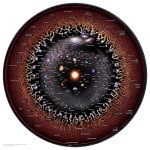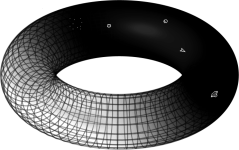I'm curious to know why the Universe is depicted in such a way.
All three diagrams simply illustrate a timeline.
The top one, which I submitted, best gives the detail of the composition of the Universe during each of its epochs.
Attached, is a logarithmic map of the observable Universe. (Note that the observable Universe is finite in its radius while the actual Universe is probably infinite.)
The map is highly detailed and is annotated, so please expand it.
In every direction we look outwards from our solar system we are peering back through time towards the Cosmic Microwave Background - the remnants of the Big Bang itself.
Note that it should not be interpreted that the Sun is at the centre of the Universe!
Attachments
Last edited:
Didn't Einstein once remark the universe is infinite but bounded? Whatever that is intended to mean.
Can something bounded be infinite?
Both bounds can be infinite or if a single bound is infinite then it will also be called unbounded sets. Also, the set of all real numbers and the set of all-natural numbers are also considered unbounded sets.
Both bounds can be infinite or if a single bound is infinite then it will also be called unbounded sets. Also, the set of all real numbers and the set of all-natural numbers are also considered unbounded sets.
Didn't Einstein once remark the universe is infinite but bounded? Whatever that is intended to mean.
The first Friedmann model of the expanding universe suggests that the universe is not infinite in space, but neither does it have a boundary. Gravity is so strong that spacetime is bent round on itself. In this model, gravity would eventually halt the expansion of the universe, leading to its collapse.
https://www.britannica.com/science/Friedmann-universe
EDITED
Last edited:
There's a good description of what an infinite, but unbounded Universe means here:
https://physics.stackexchange.com/questions/247864/what-does-finite-but-unbounded-universe-mean
It takes us back to the topology of the Universe that we considered in some depth earlier in the thread.
If the Universe is closed in on itself in all three dimensions like a three-dimensional torus, we could point a spaceship in one direction and eventually return to where we started.
The actual shape of a 3-torus universe is impossible to represent or imagine, but we can use the analogy of the 2-torus shown below instead.

https://blogs.scientificamerican.com/roots-of-unity/a-few-of-my-favorite-spaces-the-torus/
https://physics.stackexchange.com/questions/247864/what-does-finite-but-unbounded-universe-mean
It takes us back to the topology of the Universe that we considered in some depth earlier in the thread.
If the Universe is closed in on itself in all three dimensions like a three-dimensional torus, we could point a spaceship in one direction and eventually return to where we started.
The actual shape of a 3-torus universe is impossible to represent or imagine, but we can use the analogy of the 2-torus shown below instead.
https://blogs.scientificamerican.com/roots-of-unity/a-few-of-my-favorite-spaces-the-torus/
Last edited:
There's a good description of what an infinite, but unbounded Universe means here
I'm not so sharp today! That should read "finite, but unbounded" or "infinite, but bounded" if you prefer.
There is a simple example of finite but unbounded here. It uses a circle.
https://futurism.com/finite-yet-unbounded
https://futurism.com/finite-yet-unbounded
It uses a circle.
That's a useful and, as you say, simple illustration.
A finite and unbounded universe would have no edge.
In such a universe a spaceship travelling in one direction will eventually return to where it started.
This is the topology of the video game Asteroids, where a spaceship which goes off the screen on one side appears back on the other.
Attachments
Didn't Einstein once remark the universe is infinite but bounded?
Just to clarify (as he certainly put me in a bit of a tizzy) that Geoff's statement is incorrect.
In his book Relativity: The Special and General Theory, Einstein suggests "The possibility of a 'finite' and yet 'unbounded' Universe".
But the again - as for the circle in the picture - there is something outside it... just because something with mass would return, it doesn't mean that there isn't something to explore outside the circle for a mass-less entity - and thus - what's inside the circle isn't everything.
//
//
The inside or outside of the circle has no physical meaning - space is represented by the circumference of the circle.
Just like in the more sophisticated 2-torus representation where space is represented by the surface of the doughnut.
Just like in the more sophisticated 2-torus representation where space is represented by the surface of the doughnut.
My comment still stand - I just reused the concepts in your post - it applies also to a doughnut shaped universe or what not bakery... 🙂
//
//
Topology is a tricky subject for a non-mathematician like me.
However, I strive at all times to avoid half-baked ideas! 🙂
However, I strive at all times to avoid half-baked ideas! 🙂
No. It's another type of dimension but just 2D.. Follow the line which represents all space and you eventually get back to where you started. There is nothing behind space.there is something outside it...
😉 I reckon it's really a sphere. May as well explain why. If it's expanding space would increasing.
My mistake was requoting your primary mistake while directing attention to a link which carried the correct wording (post #3,066).

Anything else was simply a case of me getting my Bawbags in a twist. 😊
Anything else was simply a case of me getting my Bawbags in a twist. 😊
I reckon it's really a sphere.
Topologists, who refer to the dimensions of the surface itself, regard a circle as a one dimensional sphere and a ball as a two dimensional sphere.
The Universe could be a three dimensional sphere, i.e., a two dimensional sphere, but one dimension up.
A three dimensional sphere is hard, if not impossible, to visualise and that's why a circle and a ball are used as analogies.
https://mathworld.wolfram.com/Hypersphere.html
Learning all the time! 🤓
First off, messing with calculators is a fishy proof. What about truncating errors ????VERY INTERESTING MATHEMATICS
I want someone (or more) to watch the following YouTube video (starting about 5 min. in)
to decipher for me the exact number/fraction of the dip being explained , where fall becomes rise.
If the exact number is found >
I TRUELY BELIEVE THIS NUMBER IS AS IMPORTANT AS Pi
I understand you are interested in the minimum of the fonction x^x.
The usual approch is to find the derivative of x^x ( it seems not obvious to me, but doable with good neurones).
Then solve for 0.
It boils to:
x such that d( x^x )/dx = 0
You will find all answers, with valid proofs, here:
Last edited:
It's gravity the caters for the bending - right?No. It's another type of dimension but just 2D.. Follow the line which represents all space and you eventually get back to where you started. There is nothing behind space.
😉 I reckon it's really a sphere. May as well explain why. If it's expanding space would increasing.
But if a particle which isn't affected by gravity is on a journey, what trajectory does it take?
//
What if the radius relates to time? It becomes an unbounded 3D space other than the chance of a big crunch may return but it seems expansion is not defeated by gravity and never has been even from an infinitely small point that may or may not have existed. However gravity does have an effect on time as can speed. Time is often referred to as an arrow. Something that a continuum of some sort moves through. Space time is one. A term Minkowski came up with but bear in mind what Einstein's theory means. Certain aspects are linked.The Universe could be a three dimensional sphere, i.e., a two dimensional sphere, but one dimension up.
Going back to the bounded but unbounded circle. Sweep a 2D shape around it to form as space but that 2D space is expanding so the circumference must do as well. If so it's not bounded, the unbounded lengths also vary as well. It can't have a infinite radius it needs lots of them. So a simplistic view just doesn't work out so find one that does. That's astrophysics in many areas.
😉 A Hoyle idea was partly defeated by the need for matter to be continuously created. Not an area I have looked into. Not flavour of the month so finding out what it means may be tricky. Yet we are looking for more matter and a bit of energy to go with it.
- Home
- Member Areas
- The Lounge
- Does this explain what generates gravity?


